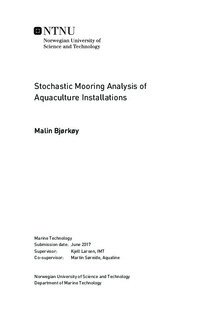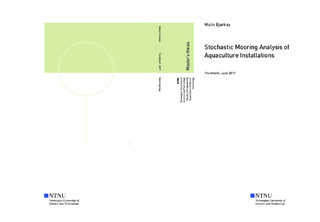| dc.description.abstract | The aquaculture industry is experiencing rapid growth, which encourages moving the installations to more exposed sites, with harsher environmental conditions. With more exposed sites comes stricter structural requirements, and the response of the installations should be assessed and documented in irregular environmental conditions to capture the realistic behavior of the structures. The variability of environmental loads is not assessed in standard regular analyses, which is the industry's "best practice" today.
Aquaculture installations are designed based on the partial coefficient method, which is an ultimate limit state design approach. The procedure is based on requiring that the extreme loads that act on the structure, represented by characteristic load, must be lower than the minimum strength of the component, represented by characteristic strength. The partial coefficient method incorporates safety factors for both load and strength, to ensure that the structure meets the design requirements that are necessary to avoid technical failure. Design load is then determined by multiplying characteristic load with a load factor, and similarly, design strength, is determined by dividing the characteristic strength with a material factor. The load factor depends on the type of design analysis conducted, while the material factor is chosen based on material and component type.
This master thesis focuses on the extreme effects of environmental conditions on a single frame moored cage system. In particular, numerical simulations of mooring line tension were performed in the simulation software FhSim, for different environmental conditions. Stochastic analyses of two sea states with 10 and 50 year return period were performed to determine the annual extreme value distribution of the load in irregular conditions. The extreme value distribution was compared to the distribution of strength, which was assumed normal distributed, and approximated based on the assumption that mean and standard deviation are related to minimum breaking load.
The resulting distribution of load and strength showed that the curves did not overlap, which indicated that the probability of failure was extremely small. According to the partial coefficient method, characteristic strength is considered equal to minimum breaking load, which represents the 90\% quantile of the strength distribution. This implies that a safety level is already inherent in the characteristic strength, before application of the material factor. After applying a material factor of 3.0, the minimum strength of the mooring line became very conservative.
The distribution of load and strength was compared to different approaches for calculating characteristic load; (i) static analyses with current only, (ii) dynamic analyses in irregular waves, and (iii) dynamic analyses in regular waves. Regular analyses based on the design wave approach gave resulting design load of more than twice as high as the irregular design load, and three times as high as the static design load in current only. The results showed that analyses based on the design wave approach are very conservative compared to irregular and static analyses. This implies that selection of analysis approach has significant impact on the requirements concerning the load the components must withstand, and the suppliers can possibly save money based on which approach they choose to apply.
Interaction between current and waves in irregular environmental conditions were inspected by isolating the response in current only and waves only, and compared to the combination of waves and current. The response analyses revealed a non-linear relationship between the combination of current and waves, and the theoretical summation of current and waves. The non-linearity occurred due to viscous drift, which are second-order effects that arise from the relative velocity between the structure and the fluid. Viscous drift caused both a mean drift force, and slowly-varying motions, which gave a significant increase in mooring line response. Slowly-varying motions are not captured by regular wave analyses.
This report concludes that design analyses should be conducted with longer time series and irregular environmental conditions to be able to study the behavior of fish farms in more realistic sea states and better capture the variability of sea loads. Challenges that comes with more exposed sites must be modelled correctly to ensure that the installations are fit for harsher environmental conditions. | en |

